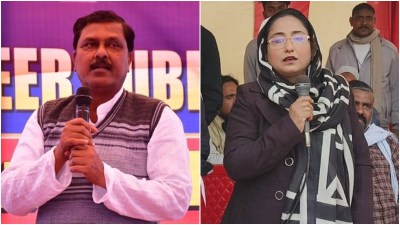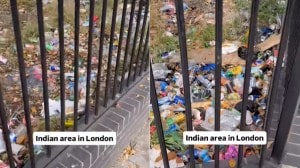De-mandal, De-kamandal
The prime minister believes that this is one of the most issue-less elections of his political career. There is no bitterness, nothing conte...

The prime minister believes that this is one of the most issue-less elections of his political career. There is no bitterness, nothing contentious, no tu-tu-main-main, he tells his friends and visitors, except probably the reappearance of old chestnuts like 1942 (in his case) and Bofors (in Sonia Gandhi’s). He has gone the extra yard to bring down temperatures. He got Venkaiah Naidu to restrain Narendra Modi over his attacks on Sonia and intervened directly when “Mian Musharraf” references appeared again in his initial campaign speeches. Some heat and dust will always be raised in an election. But so far there is no evidence of the kind of vicious, below-the-belt campaigning that we have seen in recent past.
There is evidence, actually, that it is not just a temporary change in mood, or fatigue with frequent elections. It does seem that our politics — at least its larger, mainstream body, is slowly finding the focus and the centre of gravity it had begun losing in 1989. Then corruption (over Bofors) had emerged as the bitter, divisive issue, followed by Mandal (1991), then Ayodhya, hawala and related scandals (1996-97) and Kargil (1999). Barring some distractions, this campaign seems not merely free of scams and name-calling but also devoid of ideology. Are we then beginning to see signs that forces at two opposite poles are moving closer to the median? If so, how would this influence the future course of politics? Will this pull us back from the seeming inevitability of coalition raj? Or, will this, ultimately, bring back a two-party system that our national politics has never had. For nearly 50 years it was just a one-party (Congress) system, with its opponents getting together loosely and occasionally. Subsequently, it’s been a fractious coalition situation, with no single party capable of touching the 200-mark or that magic figure of a 33 per cent vote, the minimum that should define a genuine pan-Indian party.
If the opinion polls are reasonably accurate, some of that may have begun to change, at least psephologically. The BJP may or may not reach the 200-mark and probably not the 33 per cent vote figure. But it will get close. What is more significant, the BJP and the Congress, between themselves, will probably cross the 300-mark and 50 per cent of the vote. That is an improvement. What is more important, the movement is in the same direction, of mainstream political and electoral consolidation.
Why this consolidation looks realistic, even durable, now is the convergence of the fundamental party-lines over key national issues. If you read the manifestos of the two parties, their views match not merely on economic reform, foreign policy and welfare issues but even on Ayodhya where both, primarily, lay store by the Supreme Court’s wisdom. Both parties have even fine-tuned their views on secularism. Advani defined it last week as a system that is not irreligious but where the state treats each citizen equally, irrespective of faith. The Congress, too, is slowly moving away from the classical socialist/Nehruvian definition of ideological secularism. A reading of the two manifestos will tell you how the parties have evolved their thinking on secularism towards new, and converging, central positions.
In the last election, the temple, for the BJP, was an “article of faith”. Today, it’s been left to the courts and the larger commitment — and promise — is of a “riot-free India”. For the Congress, the last time, secularism was “an article of faith”. Today, it has produced a more nuanced definition: “equal opportunities for followers of all religions and no discrimination on grounds of religion”. It then goes on to acknowledge that “most Indians are religious (and) at the same time, are respectful of other faiths”.
The future of secularism, and our constitutional stability, lies in de-ideologising that debate. Secularism should not be defined so much in terms of minorityism or majoritarianism, or a saffron, pink or red state apparatus, but as the central principle of constitutional governance guaranteeing equality, fair play, freedom to choose your gods and to worship them in any way you like, empowerment through representation and, finally, the rule of law. We may be moving in that direction.
It is not a perfect world still. Not when the NDA agenda still talks of banning cow slaughter, a national cattle commission, a law that could ultimately bar your grandchild born in upscale Connecticut or Orange County or Silicon Valley from high public offices here. Similarly, the Congress still talks of a case-by-case (suitcase-by-suitcase?) approach to privatisation while delaying labour law reform till, believe it or not, the unemployment situation is in control and a social security net is in place. I’d rather be optimistic and treat these as vestiges of a bitter, contentious past when prejudice clouded out imagination. These will slowly dissolve. It’s possible that most of these won’t be there in the manifestos five years hence.
Vajpayee’s greatest contribution as prime minister has been to convince us that coalition governments can work. Before him, coalition prime ministers were seen as transient, a kind of DSDT (Dissolution se Dissolution tak) phenomenon. Not only have Vajpayee and the NDA brought in the discipline of a real coalition, they have also convinced the people at large that if they cannot find a single party worthy of the responsibility of governing the nation they can choose one they like, in their own region or state, and that the centre would hold. But it does seem now that a reverse swing of sorts has already begun. Already, in most of our states except — and significantly — Uttar Pradesh and Bihar, a two-party system is in place. Chances are this time some of the other mavericks, Mamata, Mayawati and Laloo, will get seriously damaged. On larger national issues of the economy, governance and foreign policy, all the larger regional parties have views similar to those of the two national ones. It is therefore tempting to speculate that our politics is moving towards a two-alliance, if not yet a two-party, consolidation with a narrowing ideological gap so the issues on which they will now seek our votes would be more like governance and performance.
Every democracy has gone through a similar process through its evolution. In the US, for example, the political debate is no longer about the rights of the coloured people even if a majority of them still vote for one party. The debate is now about jobs, taxes, healthcare, welfare, religious liberalism and, most notably, foreign policy. We have not reached there quite yet. But this election could mark the closure of several old, bitter, debilitating issues. Yes, electorally, we are yet to acquire a real centre of gravity. It could only happen when the BJP and the Congress, between themselves, have at least 375 seats and 55 per cent of the vote, irrespective of who comes to power. It might, therefore, be interesting to refer back to this article when the next general election is announced, and the first opinion polls come in.
Write to sgexpressindia.com



- 01
- 02
- 03
- 04
- 05




























